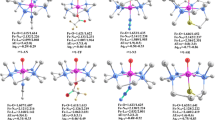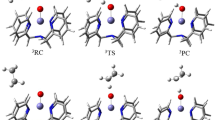Abstract
The mechanism for extradiol cleavage in non-heme iron catechol dioxygenase was modelled theoretically via density functional theory. Based on the FeII-His,His,Glu motif observed in enzymes, an active site model complex, [Fe(acetate)(imidazole)2(catecholate)(O2)]−, was optimized for states with six, four and two unpaired electrons (U6, U4 and U2, respectively). The transfer of the terminal atom of the coordinated dioxygen leading to "ferryl" Fe=O intermediates spontaneously generates an extradiol epoxide. The computed barriers range from 19 kcal mol−1 on the U6 surface to ~25 kcal mol−1 on the U4 surface, with overall reaction energies of +11.6, 6.3 and 7.1 kcal mol−1 for U6, U4 and U2, respectively. The calculations for a protonated process reveal the terminal oxygen of O2 to be the thermodynamically favoured site but subsequent oxygen transfer to the catechol has a barrier of ~30–40 kcal mol−1, depending on the spin state. Instead, protonating the acetate group gives a slightly higher energy species but a subsequent barrier on the U4 surface of only 7 kcal mol−1 relative to the hydroperoxide complex. The overall exoergicity increases to 13 kcal mol−1. The favoured proton-assisted pathway does not involve significant radical character and has features reminiscent of a Criegee rearrangement which involves the participation of the aromatic ring π-orbitals in the formation of the new carbon-oxygen bond. The subsequent collapse of the epoxide, attack by the coordinated hydroxide and final product formation proceeds with an overall exoergicity of ~75 kcal mol−1 on the U4 surface.
















Similar content being viewed by others
References
Solomon EI, Brunold TC, Davis MI, Kemsley JN, Lee SK, Lehnert N, Neese F, Skulan AJ, Yang YS, Zhou J (2000) Chem Rev 100:235–349
Spence EL, Langley GJ, Bugg TDH (1996) J Am Chem Soc 118:8336–8343
Sanvoisin J, Langley GJ, Bugg TDH (1995) J Am Chem Soc 117:7836–7837
Winfield CJ, Al-Mahrizy Z, Gravestock M, Bugg TDH (2000) J Chem Soc Perkin Trans 1 3277–3289
Bugg TDH, Lin G (2001) Chem Commun 941–952
Jo DH, Chiou YM, Que L Jr (2001) Inorg Chem 40:3181–3190
Lange SJ, Que L Jr (1998) Curr Opin Chem Biol 2:159–172
Shu LJ, Chiou YM, Orville AM, Miller MA, Lipscomb JD, Que L Jr (1995) Biochemistry 34:6649–6659
Lin G, Reid G, Bugg TDH (2001) J Am Chem Soc 123:5030–5039
Baerends EJ, Bérces A, Bo C, Boerrigter PM, Cavallo L, Deng L, Dickson RM, Ellis DE, Fan L, Fischer TH, Fonseca Guerra C, van Gisbergen SJA, Groeneveld JA, Gritsenko OV, Harris FE, van den Hoek P, Jacobsen H, van Kessel G, Kootstra F, van Lenthe E, Osinga VP, Philipsen PHT, Post D, Pye CC, Ravenek W, Ros P, Schipper PRT, Schreckenbach G, Snijders JG, Sola M, Swerhone D, te Velde G, Vernooijs P, Versluis L, Visser O, van Wezenbeek E, Wiesenekker G, Wolff SK, Woo TK, Ziegler T (2000) Amsterdam density functional program. Scientific Computing and Modelling, Free University, Amsterdam
Baerends EJ, Ellis DE, Ros P (1973) Chem Phys 2:41
Versluis L, Ziegler T (1988) J Chem Phys 88:322–328
Fonseca Guerra C, Snijders JG, te Velde G, Baerends EJ (1998) Theor Chem Acc 99:391
Bendix J, Deeth RJ, Weyhermuller T, Bill E, Wieghardt K (2000) Inorg Chem 39:930–938
Deeth RJ (1999) J Am Chem Soc 121:6074–6075
Thapper A, Deeth RJ, Nordlander E (1999) Inorg Chem 38:1015–1018
Bray MR, Deeth RJ, Paget VJ, Sheen PD (1997) Int J Quantum Chem 61:85–91
Bray MR, Deeth RJ, Paget VJ (1996) Prog React Kinet 21:169–214
Scherlis DA, Estrin DA (2002) Int J Quantum Chem 87:158–166
Siegbahn PEM (2001) J Comput Chem 22:1634–1645
Ziegler T (1995) Can J Chem 73:743–761
Bertini I, Briganti F, Mangani S, Nolting HF, Scozzafava A (1994) Biochemistry 33:10777–10784
Noodleman L, Peng CY, Case DA, Mouesca JM (1995) Coord Chem Rev 144:199–244
Kuramochi H, Noodleman L, Case DA (1997) J Am Chem Soc 119:11442–11451
Bugg TDH, Sanvoisin J, Spence EL (1997) Biochem Soc Trans 25:81–85
Bugg TDH, Winfield CJ (1998) Nat Prod Rep 15:513–530
Bencini A, Bill E, Mariotti F, Totti F, Scozzafava A, Vargas A (2000) Inorg Chem 39:1418–1425
Sokolowski A, Adam B, Weyhermuller T, Kikuchi A, Hildenbrand K, Schnepf R, Hildebrandt P, Bill E, Wieghardt K (1997) Inorg Chem 36:3702–3710
Lam WWY, Bugg TDH (1994) J Chem Soc-Chem Commun 1163–1164
Acknowledgements
R.J.D. acknowledges the support of the EPSRC. The authors also thank the referees for highlighting the hydrogen bonding issue for the REST5C structure.
Author information
Authors and Affiliations
Corresponding author
Rights and permissions
About this article
Cite this article
Deeth, R.J., Bugg, T.D.H. A density functional investigation of the extradiol cleavage mechanism in non-heme iron catechol dioxygenases. J Biol Inorg Chem 8, 409–418 (2003). https://doi.org/10.1007/s00775-002-0430-7
Received:
Accepted:
Published:
Issue Date:
DOI: https://doi.org/10.1007/s00775-002-0430-7




